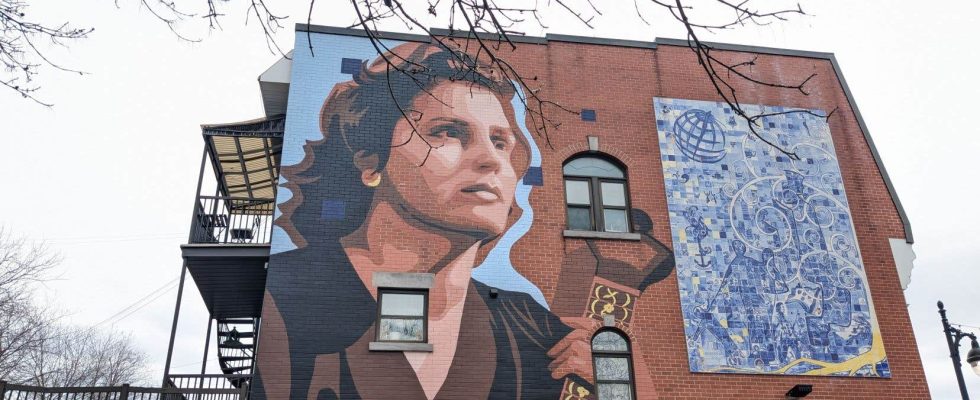This text is part of the special Pleasures notebook
In Montreal, we mainly heard about the Chinese and Italian neighborhoods. But, although many know that there is a Portuguese quarter in the metropolis, most of us could not say more. Short guided tour for a guaranteed change of scenery!
Danny Pavlopoulos is half Greek and half Peruvian, but he knows the Portuguese neighborhood like the back of his hand. Firstly because his Peruvian grandmother showed him several neighborhoods of Montreal on foot when he was a child, including this one. Secondly, because he co-founded, a few years ago, the Spade & Palacio agency, which offers “non-touristy” visits in small groups, and which offers, among other things, a walk focusing on the murals of the Portuguese quarter.
We meet on the Hand to begin the visit to the neighborhood located between Boulevard Saint-Laurent and Rue Saint-Urbain, which extends from Avenue des Pins to Boulevard Saint-Joseph. “In the 1950s, most Portuguese newcomers came from the Azores and Madeira Islands. There was an agreement between the governments: the islands lacked work, and Quebec needed men to fill jobs in agriculture and construction. Subsequently, there was a second wave of immigration following the Carnation Revolution in 1974 and the fall of the dictatorship in Portugal. These events caused a turbulent political aftermath,” explains our guide while strolling through Saint-Laurent.
While telling a piece of history, Danny Pavlopoulos points to a branch of Pharmaprix, “which was once a Jewish supermarket, Warshaw, where Portuguese chicken would have arrived in Montreal. And this, thanks to a Portuguese who convinced the owners to sell his marinated chicken.” Here, the history of the Jews and that of the Portuguese are very linked, underlines Danny Pavlopoulos. “Often, businesses that belonged to Jews passed to the Portuguese and vice versa. Their proximity is marked in the neighborhood. » Proof of what he is saying: a large mural by Leonard Cohen, of Jewish origin, at the corner of Napoléon and Saint-Dominique streets, made by the Montreal artist of Portuguese origin Kevin Ledo.
The taste of Portugal
Waves of immigration and the desire of the Portuguese to rediscover the tastes of their country have left their mark on this Montreal neighborhood. Not far from what was Warshaw, we see the Coco Rico rotisserie then the Jano. These two addresses offer Portuguese specialties: roast chicken, ribs, roast pork, Portuguese-style potatoes, chicken, pork, lamb sandwiches, sardines, grilled shrimp and squid, etc.
According to Danny Pavlopoulos, you shouldn’t hesitate to enter small local businesses either. At the Soares et Fils bakery and grocery store, he says you can find the best chorizo in town, and you can get tasty Azorean cheeses there. For its part, the Segal grocery store is known by many for its beautiful, inexpensive fruits and vegetables and for its salted and dried cod sold in the open behind the store.
On Duluth Avenue, the Portuguese Café Central instantly transports its customers into the atmosphere of an old café from the land of Carnations. The small, dark place that refuses to follow fashions welcomes mainly men who enjoy the dish of the day with a glass of wine, a beer or a port. They come there to talk about politics, watch soccer or play cards.
Back on the Main, Casa Minhota serves “really good” specialties, says our guide. Clams, octopus, cod, sardines, squid, grilled chicken, pears in port and, of course, the famous natas, sweet egg tartlets which constitute the star dessert of Portugal. But, according to Danny Pavlopoulos, if you want to taste these, the best place to do so is the Les Anges gourmets pastry shop, because they melt in your mouth.
Very close to there, it is by crossing Rachel Street that we reach the heart of the Portuguese district, specifies the guide, pointing out the Santa Cruz church, the community center of the same name as well as the Portuguese Association of Canada.
A little further north, at the corner of Boulevard Saint-Laurent and Rue Vallières, just after passing the Azores hardware store, whose window is decorated with objects reminiscent of the country, we arrive at the Parc du Portugal. We admire azulejos, columns made of blue and white tiles like those found everywhere in Lisbon and Porto. Then, a large facade with a portrait of the popular fado singer Amália Rodrigues overlooks the park, as if her spirit was watching over it.
“Few people know it,” explains Danny Pavlopoulos before ending the visit, “but we owe the colorful houses of the Plateau to the Portuguese. » From their native islands, they would have brought back to Montreal one of their local traditions, which was to paint their homes. Result: a neighborhood full of the flavors and colors of these people from Europe.
To continue discovering this neighborhood or another in Montreal, Spade & Palacio offers various group or private tours.
Thanks to Tourisme Montréal for organizing the visit.
This content was produced by the Special Publications team at Duty, relating to marketing. The writing of the Duty did not take part.
